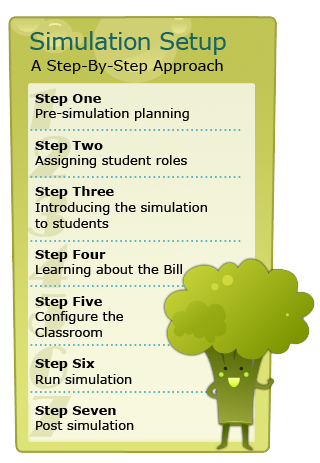FAQ
In this section you will find answers to the following questions:
- What is included in the resource?
- What is the intended age group?
- How much time is required?
- How realistic is the simulation?
- What are the intended learning outcomes?
What’s included in the resource?
The learning resource includes:
- Background materials
- Teacher preparation materials
- Student preparation materials
- Simulation materials
- Debriefing activities
- Optional extension activities
What is the intended age group?
The Vegetable Harmony Act is best suited for use with upper-elementary and middle school students, but can be adapted to secondary students.
How much time is required?
The core simulation requires 180 minutes to complete (approximately two to three class periods):
- One 75-minute session to prepare students
- One 75-minute session to carry out the simulation
- One 20- to 30-minute session to debrief the simulation
Various optional elaborations are provided that expand the complexity and length of the simulation in the following ways:
- Allowing students to research the issue
- Requiring witnesses and the minister to prepare their own presentations
- Inserting procedures that make the committee meeting more authentic
- Introducing critical thinking activities and strategies that enhance student preparedness for the simulation
The committee simulation is organized around a parliamentary committee meeting, as well as the committee's role in examining, debating, amending and reporting on the bill. Students assume the roles of senators or members of Parliament, ministers, witnesses, committee chairs, clerks and members of the press gallery.
First, students prepare for the simulation through guided classroom activities and homework assignments. Next, they use the scripts provided and their own preparation to role-play committee procedures. Suggestions for debriefing and evaluation are provided with the activities.
How realistic is the simulation?
Both simulations take inspiration from the actual committee process in the Senate and House of Commons. Although based on parliamentary procedures, the rules and procedures have been adapted to simplify the activities for educational purposes.
Current parliamentary committee practices represented in the simulation:
- The cabinet minister responsible for the proposed bill is invited to address the parliamentary committee.
- Witnesses representing groups and organizations make presentations to the committee.
- Committee members are referred to by name in a House of Commons Committee, while their electoral district names or titles are used in the House of Commons.
- Committees conduct a clause-by-clause examination of the proposed bill.
- Amendments can be proposed by committee members.
- The final vote on a bill involves a report back to the Senate or the House of Commons.
Adapted and simplified aspects of the work of parliamentary committees:
- The focus on examination of proposed legislation is only one of several roles that parliamentary committees perform. Other roles that have been left out of the simulations include examination of department estimates, review of appointments through various orders-in-council and investigation of important issues.
- The simulation includes a chair and clerk, but does not include a vice-chair and analyst.
- The extended version of the simulation includes a discussion of whether the witness list reflects the spectrum of different opinions Canadians had about the issue.
- The simulation restricts witnesses to individuals representing a group or organization, whereas, in reality, individual witnesses are allowed to appear.
- The time allotted to complete the simulation is much shorter than the time it normally takes a committee to examine a bill.
- The modified simulation does not include a clause-by-clause examination of titles and preamble, which is regularly done by parliamentary committees.
- The simulation separates committee members into Government and Opposition caucuses, whereas in committee work there is no explicit mention of political parties.
- Issues of cabinet solidarity that often influence some committee members are touched on briefly in the simulation, and there is no reference to filibustering.
What are the intended learning outcomes?
By participating in the committee simulation, students will meet the following learning outcomes:
- Understand the role parliamentary committees play in the Canadian parliamentary process
- Understand the process in which legislation is passed in the Canadian parliamentary system
- Examine the means by which citizens can influence government laws and policies in Canada
Critical thinking and communication:
- Critically analyzing a text document
- Interpreting a document from a particular perspective
- Formulating and supporting an effective argument
- Formulating effective questions
- Formulating effective counter-arguments
- Orally presenting an argument
- Evaluating the role of parliamentary committees

